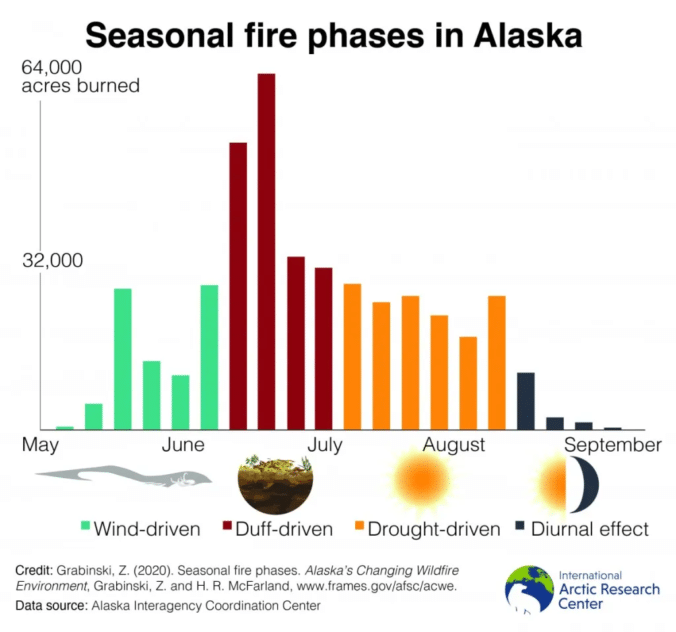By John Leonhart, Manager, AI Land and Resources Department

Spring is fast approaching and with it comes fire season in the Copper River Valley. Although snowfall has been substantial over the winter, wildfire is an ever-present danger in the region, and climatological changes, spruce bark beetle infestations, and an expected return of tourism suggest increased fire danger will continue into the near future. The Alaska fire season has been divided into four stages based on the historical fuels buildup, which represent the typical trend in seasonal landscape flammability. The following stages provide a representation of seasonality for the fire year in Alaska, with emphasis on the boreal Interior:
- Wind-Driven Stage begins in early April and corresponds to the period before full green-up when the soils are still cold and dead grasses and litter within and around communities are favorable for ignition of primarily initial attack fires and for incidents with rapid spread and growth.
- Duff-Driven Stage begins in early June and relates to longer days around the summer solstice that produce peak heating of spruce canopies and drying of the surface and immediately adjacent subsurface litter and duff fuels. Fires occurring during this period are characterized by episodic growth events related to hot, dry, sunny days, and can produce high flammability despite green fuel beds. This is normally the peak of the Alaska fire season when fires exhibit a high resistance to control.
- Drought-Driven Stage begins in the middle of July and reflects less common later-season fire growth potential and fewer additional lightning ignitions. This stage occurs in years when mid and late-summer rains do not materialize sufficiently to truncate significant fire growth potential. Fires that burn late in the year exhibit a high resistance to extinguishment. Severe drought indices can lead to fires that overwinter and re-ignite the following spring.
- Diurnal-Effect Stage begins in mid-August and is influenced by rapidly shortening days with significant reduction in solar radiation and resultant moderation of daytime temperatures and relative humidity. Shortened burn periods and high overnight humidity recovery limit the spread potential of these fires. Significant fire activity during this period is unusual and has not occurred since 2004 and 2005. Late season fire activity in 2019 was limited to areas affected by a strong wind event in mid-August, not from statewide drought, and was localized to the Susitna Valley and the Kenai Peninsula.
The 2022 fire potential outlook for the Copper River Region mirrors that of the overall fire potential for the State of Alaska. With above-normal snowpack statewide, expect a late start to fire season in the central and southern Interior and northern Panhandle. Fuels will become snow-free in late April or May, with surface fire potential rising quickly through May and early June toward the end of the wind-driven stage.
By the heart of the fire season, during the duff-driven stage, melt date is irrelevant and activity depends on fuel dryness, current weather conditions, and lightning or human ignitions. Resistance to control will increase normally and there will be some very busy periods driven by lightning, low humidity, and wind events.
With normal temperatures forecasted for mid-summer, most areas will have typical fire conditions through late July and into the drought-driven stage. If fires from the duff stage have not been controlled, they will exhibit higher resistance to extinguishment and increase acreage during hot and dry periods.
End-of-season rains are expected to arrive on time, so mid to late August fires will no longer be supported by deeper fuel layers. Existing fires will show some activity during the day, but resistance will be minimal throughout the diurnal effect stage.It is essential that everyone using Ahtna land be responsible for safe fire practices:
- Locate your fire in a place where it cannot spread
- Use existing campfire sites wherever possible
- Dig campfire pits all the way through the duff layer to the mineral soil or permafrost
- Keep water nearby in case things get out of hand
When extinguishing a fire, be sure the site is cool to the touch before vacating the area. In addition to preventing wildfires, the public needs to be vigilant and promptly contact the proper authorities to report fires spotted on the landscape. If a fire is observed, the first course of action is to immediately call 911 to report the fire. Any fires located on Ahtna land should also be reported to the Ahtna, Inc. Land Department in Glennallen at (907) 822-3476.
An Alaska Department of Natural Resources (DNR), Division of Forestry Burn Permit is good for one year and is required from April 1 through August 31 and at other times of the year as mandated by the DNR for burn barrels, maintained lawns less than 1 acre in size, and brush piles. Cooking, warming, and signaling fires less than 3 feet in diameter and 2 feet in height or commercially manufactured cooking devices (including grills, barbeques, camp stoves, hydronic heaters, etc.) do not require a burn permit but must comply with the Alaska Wildland Fire Protection statutes and regulations, and follow the manufacturers’ guidelines for safe use. Burn permits can be obtained from the Division of Forestry website (forestry.alaska.gov), the local Division of Forestry Office in Tazlina, and participating vendors in the Copper River Basin.
